Almost all chickens have some external parasites, you just don’t notice them. Neither does the chicken. The birds can live with a few lice crawling under their feathers. So can you. Chickens take dust baths to keep them under control. Lice are soft-bodied and the dirt desiccates them. Add some diatomaceous earth to their favorite dusting area, and you’ll be sure to kill off the lice – the earth is sharp and lacerates the lice. (Be sure to only food-grade DE. Agricultural DE, used to kill slugs, etc, is derived from sea creatures, is microscopically very sharp, and it will shred chicken’s soft tissues if ingested.)
Lice can get out of control and cause severe problems. In the winter, when the ground is frozen and there’s no loose dirt for bathing, the lice population will grow. In the spring, when it’s muddy and warm, the population increases even more. If your hen is elderly and arthritic, or ill and not an enthusiastic bather, you’ll have real problems.
The first place for a lice infestation is near the vent. There can be a lot of lice there and you won’t notice until the skin is bare and red. Like this.
Actually, this is Eleanor’s butt, and it’s been red and bare like this for two years. No one knows why – but it is a dramatic representation of a sad-looking bottom, isn’t it?
Every few weeks I pick my hens up, turn them upside down, and look at the feathers near the vent. Last week’s check showed what I call “lice Q-Tips.”
Those cottony masses at the base of the feathers is a sure sign of lice.
After checking all of the hens and seeing way too much of this (and some crawly bugs, too) I decided to give everyone baths. I set up three bowls – one with a tea tree oil dog shampoo, one with a vinegar and water wash, and the last for a rinse. These bowls were dumped and refreshed several times. It was a hot, sunny day and I set an x-pen up on the grass so after their baths, the girls could dry out on a clean, comfy surface.
Not everyone was equally infested. I wasn’t surprised that my older, less active hens harbored the most lice. On the other end of the spectrum was Lulu, the busiest hen of the lot, who didn’t have a louse on her. Here is her healthy bottom. Notice the many small, downy feathers. They’re so fluffy that you can’t see her skin.
Here’s another view. Isn’t that a nice bottom?
After bathing the hens, their pens got raked and DE was put down. My oldest and most infested hens also got a dusting of commercial louse powder. Eleanor will never have a fluffy bottom, like Lulu, but she’s a lot more comfortable.
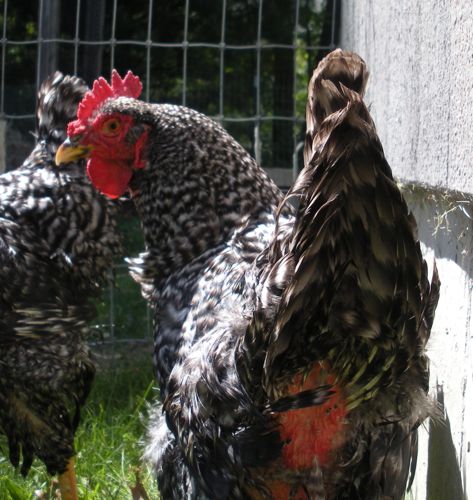
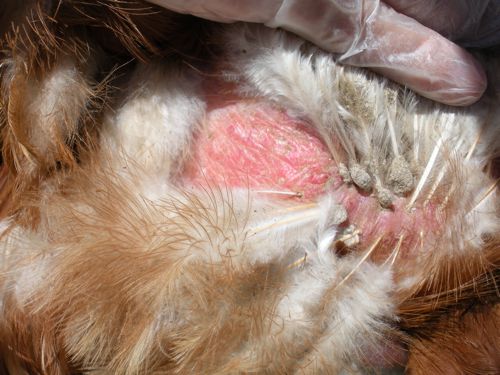
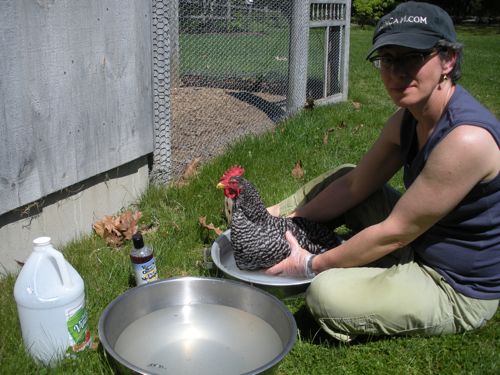
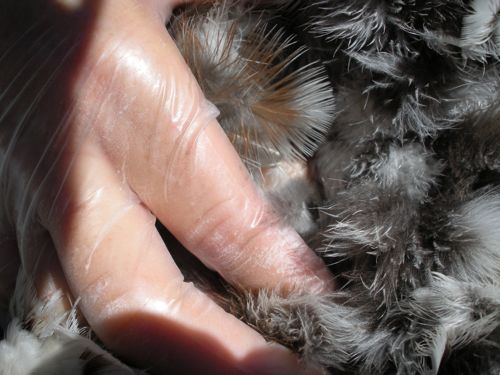
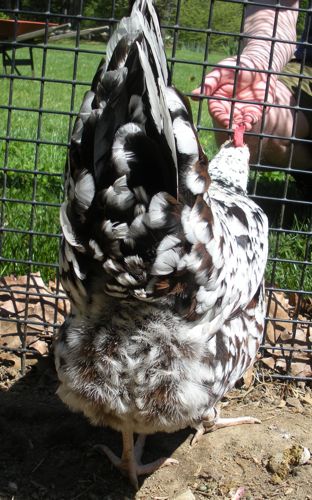
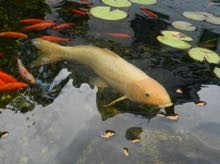
I would have been lice free too!! I would have had more solution on me then the hens in the end. I can’t imagine my hens being as calm and quiet as that barred rock in the photo.
Ken, my hens are used to being handled. Also, I think they like the baths! But, that’s not to say I didn’t get plenty wet.
Thanks for the pictures and the solution to this problem. I just bought a 50 bag of DE supposedly food grade, but it is the white powder. I haven’t been able to find DE anywhere locally and finally found someone selling it out of the paper. He picks it up in Las Vegas and brings it back to Utah. He uses it for chickens and so I assumed it was what I wanted. Where do you get the right stuff?
Wendy
Wendy, the only DE that I’ve seen that’s safe for consumption is brown, but maybe someone makes white? What did the label say on yours? I special ordered mine from my local feed store.
I get my DE from My Pet Chicken which is food grade and is a white powder. This is great stuff. I would highly recommend this to everyone.
I can’t see any of mine standing for that (except Gladys who has had more baths than me and quite enjoys the process, especially the blow-dry). We have a great aerosol here called Johnson’s Lice and Mite spray – I wait until they’re roosting, then everyone gets a spray under the wings and round the bloomers. And that’s that! One application does it – if I can pick the ‘nits’ from the more biddable hens I do; otherwise a spot of plucking may be in order. I find they don’t mind if you do it quickly and put raisins in the other end…
Since your hens like them so much, I tried raisins with mine. They don’t like them! They do like grapes, though.
Do you spray in the dark? If I turn the barn light on, they get up and about.
Raisins! Mine like my mom’s red beans and rice leftovers. They go wild when they smell me coming with what’s left over.
We have mites out here..little red things that hide very well in the feathers. Do you get those too? Since we actually had rain this year, they are out in full force. Thank you for the information, Terry…DANG..those lice are disgusting! P.S. Getting 15 new babies the end of the month. Finally broke down and ordered some plain old sturdy breeds, no more fancies for a while….Those fluffy babies are so fun!
Donna- those blood-sucking red mites are everywhere! I know folks in England and Australia who have had them in their coops. Really tough to get rid of because they hide in cracks in the wood and come out at night. I’ve heard it helps to totally clean out the coop, then disinfect with bleach/water. (old timers used kerosene – but I’d rather avoid that.) Air out. Paint so that there’s fewer places for them to hide. Use a commercial miticide if it’s bad. If any of my readers have battled mites, chime in!
I’ve only had a bout of mites once – on a very sick hen. We got rid of all of the old bedding and aired things out. Haven’t had a problem since, but we were very lucky. Even the best poultry keepers get mites – especially when the weather gets warm and wet.
I think if you have mites actually living on the bird they will be Northern Fowl mite which is a nightmare to shift – Ivermectin (not licensed for poultry but then what is?) is effective, as a drop-on on the back of the neck, as one would do with a cat flea treatment.
Red mite normally only live in the house. I poof DE round the perch notches and in the nest boxes and it seems to keep them under control until the really hot weather. Then it’s a case of dismantle and squash! A good ‘organic’ method is to blast them with a blow-torch and they crackle pleasingly! The heat gets into the cracks and kills the ones you can’t see…
Terry, what on earth is wrong with your chickens? Mine would kill for raisins (although sultanas are preferred)and will leap up to grab the bag from my hand.
Thank you for this info, Terry…I have some DE and I did scrap the whole coop out and checked everyone and got them dusted as well. I will give it another good cleaning with bleach and water when it warms up a bit….never a dull moment!
Many years ago we used Malathion (an organophosphate broad-spectrum insecticide that is considerably less toxic to mammals than parathion) to control lice in large populations of chickens. A dab at the upper base of the the tail, near the oil gland did the trick. The location assured that each chicken would spread the insecticide all over when preening. With small populations, DE and sitz baths also work very well.
Great information and great pictures.
I am about to embark on this wonder world of raising chickens. I am eagerly awaiting my first order in 3 weeks (a variety of Bantams). I have concerns after reading the blogs about mite and lice problems. I saw a product on the Welp Hatchery website called “Poultry Protector.” It claims to treat lice, fleas, and mites with this spray-on treatment. Not sure what active ingredients it contains other than it states “enzymes”….has anyone heard or used this product before?
Gigi
The best thing you can do is to keep them clean and give them a place for dirt baths. I’ve heard of that spray, but haven’t used it.